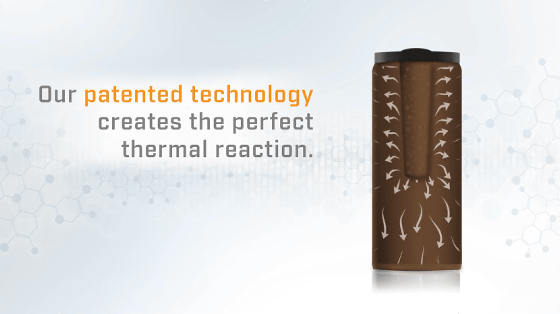The history of 'a container that can be heated' where a hot meal can be taken everywhere

There are ones that use heated containers for station ladies. It generates heat by reacting calcium oxide with water so that you can eat warm lunch everywhere. Such a "heating container" was also used for the soldier's meal at the time of World War II.
Self-heating drinks cans return - here's how they work
https://theconversation.com/self-heating-drinks-cans-return-heres-how-they-work-98476
One of the main plans in the Normandy landing campaign was to destroy the gun set up at Cape Ocs but the grenades used to destroy this gun are not ordinary things to cause explosion, It used to generate high heat.
The thermite reaction is a very easily available chemical reaction using iron oxide and powdered aluminum. Since the mixture of iron oxide and aluminum is stable, there is no need to worry about handling, and ignition using magnesium ribbon etc. will burn up violently at a stroke while generating high heat of more than 2,500 ° C. The state of the reaction can be confirmed by slow motion from the following movie.
Thermite reaction in slow-mo - YouTube
The thermite reaction was an extreme example of an exothermic reaction, but the most familiar example to us is combustion of carbon and oxygen. Also, the reaction between calcium oxide and water used for heating type station valves is also an example of an exothermic reaction. These exothermic reactions were also used for the meals of soldiers during the Second World War.
The can filled the soldiers' soup had a hole in the center, and putting the cordite as the fuel in the center put it in and it was possible to prepare a hot meal in about 5 minutes.

Since cordite often had a problem of explosion, numerous attempts to heat up in another way have been done. Although the reaction between calcium oxide and water used in station valves is less dangerous, the amount of heat generated is small, and if you try to heat the liquid to 40 ° C, you must prepare the same amount of heating agent as the liquid.
HeatGenie, which develops heat generation cans in companies that are trying to heat foods by utilizing reactions that generate heat efficiently such as Thermit reaction even in modern times. The thermite reaction generates high heat that melts iron, so somehow it is necessary to lower the temperature. Therefore, by reacting silicon dioxide with aluminum instead of iron oxide, it is possible to cause a temperature-sensitive reaction to occur.
According to HeatGenie, it is possible to make hot coffee in 2 minutes by heating the container only to 10% of the container by utilizing the structure "firewall" which blocks the heat generation portion and "heat sink" which efficiently conveys the heat to the drink I can do it. Thanks to these efforts, HeatGenie successfully raised $ 6 million (about 660 million yen).

Related Posts:







